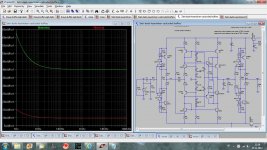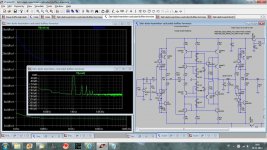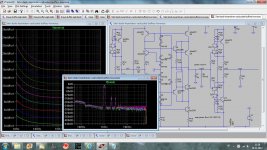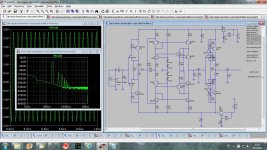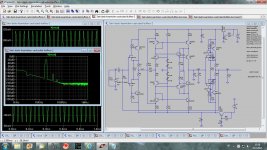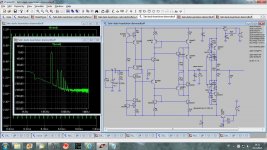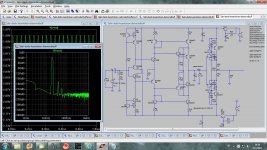As I don't have the models nor real fets with a higher pinchoff voltage I did it in this way. Distortion is down but not so much as I expected.
You will get slightly better results probably with a higher-pinchoff device, but you can also use floating voltage sources in sim. And as well, you can use DMOS and floating voltage sources. My results for the input buffer alone, a 10k source resistance, 20kHz 1V peak, were -113.7dBr at the input and -113.4dBr at the output for 2N4391/2N5114 as cascode devices; with a 2N7000 and a ZVP3306 and a 7V floating gate bias, these results got to -119.0dBr input, -118.1 dBr output. Note that the greater spread in the input and output numbers suggest we're started to see a larger contribution from the basic stage, barely.
The 7V floating voltage is not as bad to implement as it may sound, as photovoltaic optocouplers have around this amount of open-circuit voltage. Alternatively, since they last the shelf life, batteries will work.
But the 246/103 are nice, as they have high breakdown voltage. Unfortunately they are scarce.
I know Curl suggested the 2N4416 to use in place of SK170 for lower capacitances, but I don't think there is a P channel equivalent.
Why worry about distortion so much? It is vanishingly low and the profile is good, no high order harmonics. I think it is time to address noise performance and other things, in case the low distortion may be for naught.
Why worry about distortion so much? It is vanishingly low and the profile is good, no high order harmonics. I think it is time to address noise performance and other things, in case the low distortion may be for naught.
I know Curl suggested the 2N4416 to use in place of SK170 for lower capacitances, but I don't think there is a P channel equivalent.
Why worry about distortion so much? It is vanishingly low and the profile is good, no high order harmonics. I think it is time to address noise performance and other things, in case the low distortion may be for naught.
If low distortion is easy to do, it should be done IMO. And it's worthwhile to understand the mechanisms. I find the "distortion at the input" behavior is often neglected, and I was pleased to see an explicit discussion in Self's recent Small Signal Audio Design.
But certainly noise is another critical parameter, in fact I tend to worry about it more than distortion per se. A quick glance at the current amp portion suggests that things will be dominated by thermal noise of key resistors, with the input and output buffers and other semiconductors a relatively small contribution.
And yes, there are no P channel equivalents to the process 50 (2N4416, 2N5486, etc.). Motorola used to make some not-too-far-off parts (MFE4012 for example) but they have been gone for ages. And it's hard to deal with the low mobility of holes in Si, the reason why the SJ74s have to be so big and high capacitance to have comparable transconductance and noise.
Yeah, input distortion is not talked of much. You can increase OLG to the moon but eventually it does not gain you anything because it only decreases load-dependent distortions. For instance Early affect on the input transistor is input-dependent, not load dependent, and NFB cannot fix this, only cascoding. Miller compensation is another good example. Regardless of whether the amp is under load or not, the miller cap always loads the circuit and creates a distortion lower limit.
When one starts to think in terms of rejecting and isolating distortion, rather than attenuating it, the need for tons of feedback and high-gain stages diminishes. The Baxandall mirrors are a critical part of this circuit.
When one starts to think in terms of rejecting and isolating distortion, rather than attenuating it, the need for tons of feedback and high-gain stages diminishes. The Baxandall mirrors are a critical part of this circuit.
Very nice topology with great results. What happens when the 47K's go to the output instead of the jFET source? -RNM
Thanks RNM,
when I did it with the input buffer distortion increased slightly, and with the output buffer no change.
Damir
A quick glance at the current amp portion suggests that things will be dominated by thermal noise of key resistors, with the input and output buffers and other semiconductors a relatively small contribution.
Ooops must have forgotten to hit Submit.
A rough-out on noise revealed the base current shot noise of Q5 and Q7 to be significant. As well those transistors have somewhat high rbb', according to Gerhard about 130 ohms for the BC550 for example. So we could help things out with lower rbb' parts, and fixing some of the base current noise effects. Note that the substantial base current for the output devices is recycled by the auxiliary parts and makes only a small contribution.
I also had to raise the bias current for Q10, the lower auxiliary PNP, to prevent it "running dry" at about 10V rms out. I went to 50k for both bias resistors.
BC327/337 are better in the low-Rbb department, so I've been told, and they have great quasi-saturation characteristics just like the BC5x0.
I'm a bit confused about noise, the BC5x0 series is supposed to be low-noise, but is supposed to be noisier than the BC3x7 series which doesn't have noise in its datasheet.
I'm a bit confused about noise, the BC5x0 series is supposed to be low-noise, but is supposed to be noisier than the BC3x7 series which doesn't have noise in its datasheet.
BC327/337 are better in the low-Rbb department, so I've been told, and they have great quasi-saturation characteristics just like the BC5x0.
I'm a bit confused about noise, the BC5x0 series is supposed to be low-noise, but is supposed to be noisier than the BC3x7 series which doesn't have noise in its datasheet.
Many times manufacturers have produced a part for a specific application and touted it as such (e.g., "saturated switch") and in the process wound up with a low base spreading resistance, which others then discover to have low noise at sufficient collector current and low source impedances. A classic example was the Motorola 2N4403, which in its day gave very good results for low source Z compared to so-called "low noise" devices.
Historically, the transistor moniker "low noise" has been extensively misapplied irrespective of impedance. Often the achievement of high beta, hence potentially low current noise, has been at the expense of thermal noise from rbb'. But it is possible to get both low resistance and high beta. The now-sadly-discontinued 2SA1316 and 2SC3329 have 2 ohm rbb' and high beta as well. Note that to have parity between thermal noise and referred collector current shot noise the devices need to be operated at about 7mA. Then with beta of 500 and thus Ib of 14uA, the shot noise in that current (the minimum of current noise) is about 2.1pA/sqrtHz, which will contribute according to the source impedance another equivalent input voltage noise term.
Yep if that 40nV/sqrtHz is output noise, that's quite close to what I roughed out.Noise
CMR
CMR? both ways?
Thanks RNM,
when I did it with the input buffer distortion increased slightly, and with the output buffer no change.
Damir
CMR? both ways?
CMR? both ways?
RNM I have to find out how to simulate CMR, I am quite new in spice simulation.
The main noise contributor is current conveyor input resistor(R28). Changing BC5.. transistors to 2sa970/2sc2244 dropped the noise from 40nV/sqrtHz to 37nV/sqrtHz only.
To have the same gain with lower input resistor I changed CM to equal current in both legs and here is simulation I called low noise low distortion. Additional benefit is lower dissipation of Q6 and Q8 and there are low power transistor good enough now.
If I want to keep that low noise high impedance input volume control is no no. Output resistor(Rout) could be used as an atenuator but 1k only and that is not easy to get by. Any suggestion??
Damir
Attachments
you can replace Q3 and Q4 and diodes by complicated buffer as enployed in input and output.
by the way, if you do not intend to use global loop feedback,as CFB opamp,
it may be easy to obtain better performance with folded cascode instead of current mirror.
there are some discussions about similar circuit.
http://www.diyaudio.com/forums/digi...-sen-evolution-minimalistic-iv-converter.html
http://www.diyaudio.com/forums/digital-source/217459-dac-i-v-convertion-very-low-distortion.html
by the way, if you do not intend to use global loop feedback,as CFB opamp,
it may be easy to obtain better performance with folded cascode instead of current mirror.
there are some discussions about similar circuit.
http://www.diyaudio.com/forums/digi...-sen-evolution-minimalistic-iv-converter.html
http://www.diyaudio.com/forums/digital-source/217459-dac-i-v-convertion-very-low-distortion.html
There are two examples of the line amps that I think could be good to be built. Both are very close regarding distorstion and noise. Here is the first one. Input 0.3 V and 0.01 V.
Which one to build?
dado
Which one to build?
dado
Attachments
The second one, same input voltage.
dado
Hello ''dadod'',
I would kindly suggest the last SCH from a 4 th published.
Excellent results You achieve there
Congratulations

Best regards
Andreas
Hello ''dadod'',
I would kindly suggest the last SCH from a 4 th published.
Excellent results You achieve there
Congratulations
Best regards
Andreas
Thank you Andreas,
There are two schematics only, shown with two different input signals, and you can see all details of the schematics by clicking on the down left corner.
Damir
Thank you Andreas,
There are two schematics only, shown with two different input signals, and you can see all details of the schematics by clicking on the down left corner.
Damir
Hello ''Damir''
Yes I know, and from the two I would gladly chose the second one with absent of 7th harmonic
Well after it'll be built .... yes the PCB design, components influences, and all related other parasitics will take their places would surely be different but for sure this is very, very good starting point and the final proto might even surprise you with the very low distortion sound
Best regards,
Andreas
- Status
- This old topic is closed. If you want to reopen this topic, contact a moderator using the "Report Post" button.
- Home
- Source & Line
- Analog Line Level
- Current conveyor as a voltage amplifier
